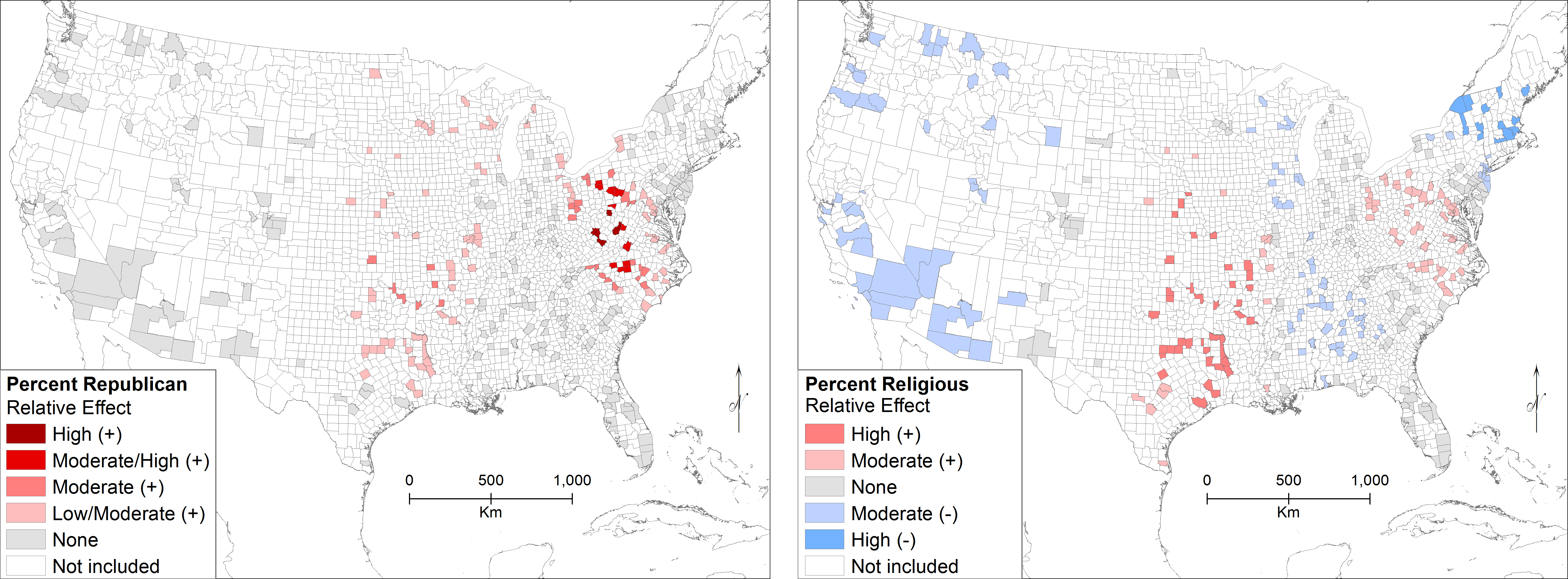In a new study, University of Utah geographers sought to understand the factors fueling hate across space. Their findings paint a rather grim reality of America; hate is a national phenomenon, and more complicated than they imagined.
The researchers mapped the patterns of active hate groups in every U.S. county in the year 2014, and analyzed their potential socioeconomic and ideological drivers.
They found that in all U.S. regions, less education, population change, and ethnic diversity correlated with more hate groups, as did areas with higher poverty rates and more conservative political affiliation. The magnitude of the drivers had regional differences, however. The regional variation of the proposed drivers of hate may be a result of diverse ethnic and cultural histories. One surprising finding is that the geographical region seemed to determine whether religion has a positive or negative relative effect on the number of hate groups for the county.

PHOTO CREDIT: Medina et al., 2018, ⓒTaylor & Francis 2018
Reported by the Southern Poverty Law Center, 2000-2014
The U geographers assert that organized hate is motivated by the desire to protect a place from the perceived threats that ‘outsiders’ pose to identity and socioeconomic security. The contemporary expression, ‘hate,’ is shaped by the intermingling histories and present-day conditions of a place.
“There is a lot of uncertainty in the country today, and a lot of change. For those involved in hate group activities, they see their actions as a way to secure the future of their people. Unfortunately, that fear turns to hate, and in the worst case, violence,” said Richard Medina, assistant professor in the Department of Geography at the U, and senior author of the study.
“Hate is a geographic problem. The ways people hate are based on the cultures, histories, ethnicities and many other factors dependent on place and place perception.”
The study published online in the Annals of the American Association of Geographers on Feb. 9, 2018.

PHOTO CREDIT: Richard Medina adapted from Medina et al., 2018, ⓒTaylor & Francis 2018
The relative effect of four socioeconomic factors on the number of hate groups per 1,000 people for U.S. counties in 2014. Red indicates that the factor has a positive effect on the number of hate groups in the county, blue indicates that the variable has a negative effect on the number of hate groups in the county, and a darker shade indicates a stronger effect.
A grim reality
“When thinking about hate and place, it really boils down to thinking about identity,” said Emily Nicolosi, co-author and doctoral student at the U. “Some people have strong feelings about who belongs, and who doesn’t belong in ‘their’ place. When they see people coming in that they think don’t belong, their very identity feels threatened.”
A hate group is an organized group or ideology with beliefs or practices that malign an entire class of people due to their immutable characteristics, according to the Southern Poverty Law Center (SPLC). Whether it be their race, gender, religion, ethnicity, disability, or sexual orientation, a hate group expresses prejudice against people with a particular identity. Though hate has always existed, 2016 saw a near-high in the number of hate groups in the United States, according to the SPLC. There is still much to learn about how Americans hate, and why.
The researchers mapped active hate groups for every U.S. county using the SPLC database from 2014. They compared the relationships between these groups with the county’s socioeconomic factors, meant to represent diversity, poverty, education level and population stability, and ideological factors, represented as religion and degree of conservativism.
“People hate for different reasons because U.S. regions have different situations and histories. For example, the Northeast is a place of power that may be seen as elitist and well-educated. Is there still hate? Yes. Some of the reasons people hate there are different than in the South, where there’s a different history of the Confederacy, of discrimination, and so on,” said Nicolosi.
While this is not the first study to quantify hate groups at the county level, it is one of the first to look more regionally and analyze variations in space explicitly. Previous research has focused on why people hate, but all populations are typically analyzed together in a national model. Until now, the drivers of hate have never been differentiated for specific places.
What’s next?
Medina and Nicolosi want to analyze the differences between different types of hate groups, and whether hate groups are linked to violent behavior.
“First and foremost, I want our paper to help people understand how much we don’t know about hate—hate is not a uniform phenomenon. Hopefully this study motivates people to start asking more questions, especially right now,” said Medina. “We have a long way to go before we really understand the drivers and patterns of hate in this country.”

PHOTO CREDIT: Richard Medina adapted from Medina et al., 2018, ⓒTaylor & Francis 2018
The relative effect of ideological factors on the number of hate groups per 1,000 people for U.S. counties in 2014.
Simon Brewer and Andrew Linke of the Dept. of Geography at the University of Utah also contributed to this study. The paper was published by Taylor & Francis Group.
About Taylor & Francis Group
Taylor & Francis Group partners with researchers, scholarly societies, universities and libraries worldwide to bring knowledge to life. As one of the world’s leading publishers of scholarly journals, books, ebooks and reference works our content spans all areas of Humanities, Social Sciences, Behavioural Sciences, Science, and Technology and Medicine.
From our network of offices in Oxford, New York, Philadelphia, Boca Raton, Boston, Melbourne, Singapore, Beijing, Tokyo, Stockholm, New Delhi and Cape Town, Taylor & Francis staff provide local expertise and support to our editors, societies and authors and tailored, efficient customer service to our library colleagues.




